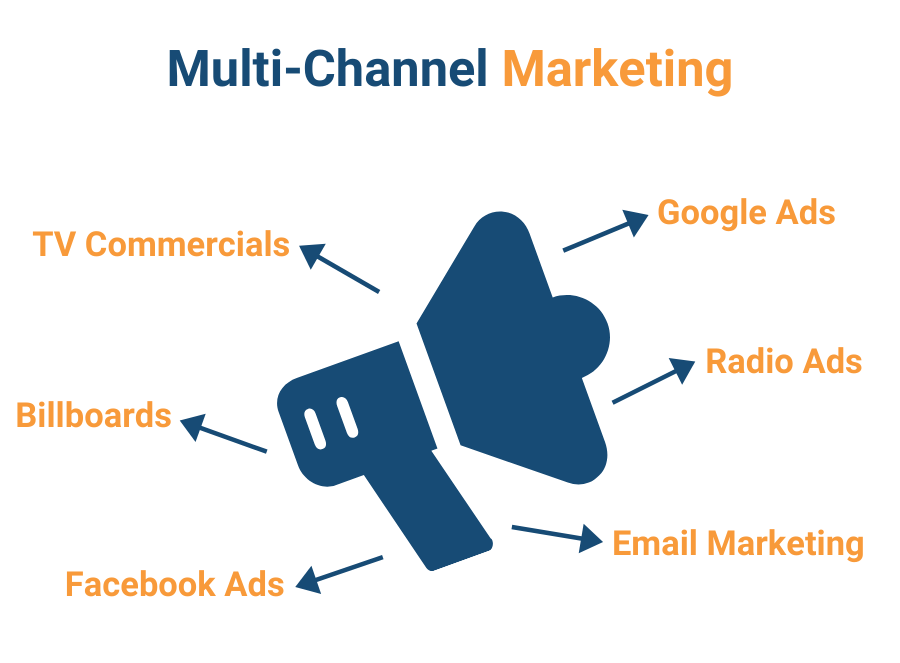To build brand loyalty in today’s competitive landscape, you must ensure you’re everywhere your customers are.
A multi-channel marketing approach can help you craft the right message through your consumers’ preferred channels. You’ll understand specific marketing needs better, and your overall return on investment will likely increase.
As shopping across different services grows, businesses must invest in multi-channel marketing campaigns to help their brands maximize exposure to their target audiences.
What Is Multi-Channel Marketing?
Multi-channel marketing refers to using different marketing channels to engage prospects and customers.
With 73% of consumers using multiple channels during the customer journey, multi-channel marketing is more important than ever. Most shoppers aren’t going through a single channel to make purchases anymore. They’re looking at various channels to decide whether to buy a product or service.
With 73% of consumers using multiple channels during the customer journey, multi-channel marketing is more important than ever Click to tweetMulti-channel marketing refers to both online and offline channels. You can invest in email and social media marketing (online) and integrate traditional marketing efforts, like TV ads and direct mail (offline). It’s about creating more touchpoints with potential customers.
Multi-channel marketing is also distinct from omnichannel marketing. The former creates different customer experiences through various channels, while the latter focuses on one unified customer experience using other media.
The Benefits of Multi-Channel Marketing
Multi-channel marketing helps increase brand exposure. Its simple premise is that your brand becomes more visible through several channels than just one. People might see your brand online on a social network and offline on a billboard ad. The more places your brand appears, the more people will see it.
That exposure gives consumers more opportunities to engage and connect with your brand. You can reach users across several channels and reach consumers anytime and anywhere: at work, at home, or even in social settings. You’re not limiting your marketing strategy to a single channel that can be accessed only at a specific part of a consumer’s day.
Multi-channel marketing also helps you accurately cater to your buyer personas. Tailor your marketing efforts to reach potential customers on the channels of their choice. For example, you might invest in marketing through text messaging or apps for consumers on smartphones and other mobile devices. If your buyer persona is more traditional, targeting them through newspapers or magazines may be a better fit.
Research also shows that multi-channel marketing often leads to more purchases. On average, multi-channel customers spend three to four times more than single-channel customers. Consumers who see ads on multiple channels also have a 24% higher conversion rate than those who see them via one channel.
Why is that? It may be because consumers on multiple channels are exposed to more products and services than single-channel customers. That exposure often leads to consumers with high lead scores who are close to being purchase-ready.
How to Implement a Multi-Channel Marketing Campaign in 3 Easy Steps
To build a multi-channel marketing campaign for your business, choose your channels, create channel-specific assets, and track your campaign performance.
Step 1: Choose Channels Based on Research
The first step of any multi-channel marketing strategy is to dig into research and metrics you already have. Start by looking at your customer data to see which channels have led to solid results in the past. You want to identify channels with a high ROI and, perhaps more importantly, increased customer engagement.
From there, find the most successful channels for each audience segment. Look for patterns to see what members of your target audience are going to specific channels. Are younger audience members in big cities on Instagram? Are older audience members in smaller towns on Facebook?
Implementing the Growth-Share Matrix is a great way to determine which channels to use. This framework will allow you to break up your channels into four growth categories to see which ones are worth investing in and which ones you should avoid putting more marketing dollars into.
There’s no rule about the number of channels you should use, but four to six can help you get a manageable start.
Step 2: Create Channel-Specific Assets
You can’t create one ad and launch it across various channels. Ensure all your content is unique and fits the channel you’re sharing it on.
Find out what types of content perform well on different channels. For example, if you’re targeting consumers via Google ads, you’ll want concise writing that immediately grabs a consumer’s attention. You don’t have the luxury of a lengthier blog explanation.
Remember that each channel has quirks, but you want a unified brand voice and tone.
Depending on your budget, enlist a writer, graphic designer, and videographer to help create content across different channels. Your creative team should be able to write and design content for other channels and understand how distinct they are.
Step 3: Track Campaign Performance Across Channels
Once your research and content are in place, you must track your campaign performance. Choose an attribution model to determine which channels are most effective. These models can help uncover how customers engage within different channels and their actions before converting.
Here are some standard attribution models used by companies:
- First-click attribution: Full credit goes to a consumer’s first action on their customer journey.
- Last-click attribution: Full credit goes to the consumer’s last action to become a customer.
- Linear attribution: Each consumer action gets equal credit on their journey to becoming a customer.
- Time-decay attribution: A consumer’s most recent actions are given more credit.
- Position-based attribution: More credit is given to consumer actions at different stages of the lead life cycle.
Whatever attribution model you choose, consider tracking customer data using customer relationship management (CRM) software.
Once you have all your customer data, you must analyze it carefully. Look for trends in your marketing funnel to see which channels consumers engage with most.
Based on this information, reallocate your marketing budget to channels based on customer data. Content trends change rapidly, so stay on top of each channel to ensure you get the most out of your ad spend.
Bonus Tip: Consider retargeting ads if you’re running a multi-channel marketing campaign. With this marketing tactic, you can retarget ads to other channels after users have left your website. The more channels you’re on, the more opportunities you’ll have to retarget ads to users.
Expand Your Reach with Multi-Channel Marketing
A lot of marketers tend to view different marketing channels in silos. However, for a multi-channel marketing campaign to be effective, you need to see channels independently working toward the same goal of converting customer groups.
Source: blog.alexa.com




![What Is SEM? [Paid Search Guide]](https://competico.com/wp-content/uploads/2022/07/What-Is-SEM-300x167.png)


